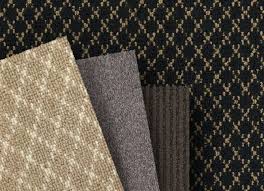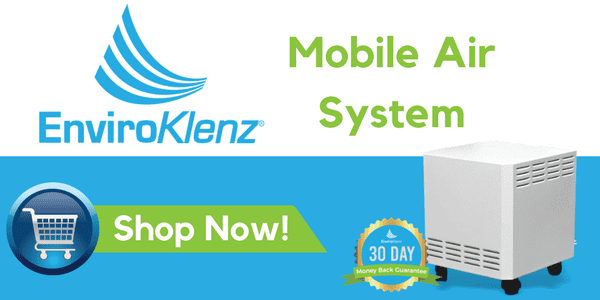New Carpet Can Be Hazardous to Your Health
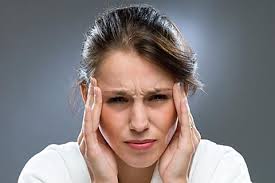 If you are concerned about toxic exposures and are doing things like eating organic food and drinking filtered water, you’ll want to also do something about your wall-to-wall carpet.
If you are concerned about toxic exposures and are doing things like eating organic food and drinking filtered water, you’ll want to also do something about your wall-to-wall carpet.
With few exceptions, wall-to-wall carpets are made from synthetic materials derived from petrochemicals.Synthetic carpet is made from a complex blend of more than 100 different industrial chemicals. When installed in a home, these carpets can release chemicals into the air, causing a variety of health effects that reach every part of the body.
The government began investigating new synthetic carpeting as a source of indoor air pollution after a 1988 incident at the offices of the Environmental Protection Agency (EPA). When more than 10 percent of the employees reported symptoms after exposure to new carpeting, the EPA, the Consumer Product Safety Commission (CPSC), and other groups began investigating the toxicity of synthetic wall-to-wall carpeting.
Reported symptoms were as diverse as burning eyes, memory problems, chills and fever, sore throats, joint pain, chest tight¬ness, coughing, numbness, nausea, dizziness, light-headedness, blurred or double vision, nervousness, depression, and difficulty concentrating. Many reported newly acquired chemical sensitivi¬ties after a few days to a few weeks of exposure, and some re¬quired hospitalization.
EPA employees made their own analysis of the air-quality data. Based on information from a 1987 University of Arizona study on carpeting which isolated the chemical compound 4-phenylcyclohexene {4-PC), they began to monitor for this chemical and found it to be the culprit.
4-PC) is a by-product created when styrene and butadiene are combined to make the latex backing that is used on almost every carpet. Creation of 4-PC is unpredictable—it may be in one sample and not in another.
While industry claims that animal tests show 4-PC to be harmless, an EPA risk-assessment group predicted that it could create a nervous system and genetic problems.
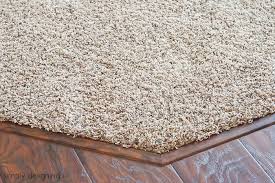 Levels of 4-PC to 20 parts per billion (ppb) have been mea¬sured in new carpet. This is the chemical that creates “new car¬pet smell.” Four days after installation, levels fall to about 10 ppb, and after about two months, levels decrease to approximately 1 to 2 ppb. You can smell 4-PC down to about .5 ppb. Thus, the EPA has determined that synthetic carpet is a major contributor to in¬door air pollution.
Levels of 4-PC to 20 parts per billion (ppb) have been mea¬sured in new carpet. This is the chemical that creates “new car¬pet smell.” Four days after installation, levels fall to about 10 ppb, and after about two months, levels decrease to approximately 1 to 2 ppb. You can smell 4-PC down to about .5 ppb. Thus, the EPA has determined that synthetic carpet is a major contributor to in¬door air pollution.
Today the carpet industry has reduced, but not eliminated, the use of toxic chem¬icals in carpeting. While carpets are a somewhat safer than they in 1988, there are still toxic problems associated with carpets.
In addition to the toxic exposure from the carpet itself, another concern comes from the ability of the carpet to trap and hold airborne household volatile organic compounds (VOCs) as well as lawn-care chemicals tracked in from outside. This is known as the “sink effect.” Eventually, these chemicals become a hazardous part of house dust, along with particles from the carpet fibers themselves, which are released into the air as the carpets wear.
In addition, carpets are treated with pesticides (antimicrobials and mothproofing), soil repellents, moisture repellents, and other finishes. The polyurethane foam padding underneath often outgasses vapors of toxic chemicals such as formaldehyde and pentachlorophenol (from the backing). And if the subfloor is particle board, even more, formaldehyde is being released in the room, right through the carpet.
Yet another layer of toxins is applied when you clean the carpet with carpet shampoo.
The active ingredient used in most rug, carpet, and upholstery shampoos is perchloroethylene, a solvent com¬monly used as a spot remover. It is a known human carcinogen, and its immediate effects can be light-headedness, dizziness, sleepiness, nausea, tremors, loss of appetite and feelings of dis¬orientation. Long-term exposure may result in damage to the liver or central nervous system.

Rug, carpet, and upholstery cleaners may also contain naph¬thalene, which, according to The Condensed Chemical Dictio¬nary, is “toxic by inhalation.” Headaches, confusion, nausea and vomiting, excessive sweating, and urinary irritation can all result from exposure. Naphthalene is also suspected of causing cancer in humans. Ethanol, ammonia, and detergents are other com¬mon ingredients in these products.
With all these toxic chemicals outgassing from carpets and their cleaning agents, carpet by itself becomes a major source of indoor air pollution. Since most homes today keep windows closed to save energy, and HVAC systems recycle indoor air, concentrations of pollutants being released from carpets build up and build up to dangerously high levels.
One solution is to remove all the carpet and replace it with a nontoxic flooring such a ceramic tile or prefinished hardwood. But this can cost thousands of dollars for a whole house, and disrupt the household while the change is being made.
Another solution is to get several stand-alone air purifiers for various rooms in your home, or special filters for your HVAC system that remove these chemicals from the air. The EnviroKlenz Mobile Air system goes beyond standard particulate removal and provides the end user with a two-step filtration process which is designed to remove particulates and VOCs from your indoor air. The technology does not release any chemicals back into your environment and is equipped with a 4-speed blower with speeds that range from whisper mode-high.
To remove chemical odors and VOCs associated with new carpet place the EnviroKlenz mobile air system in the center of the room. Allow to the unit to run on high for 4-8 hours. Depending on the size of the room an extra unit may be needed or for homes with an HVAC or furnace system, an EnviroKlenz filter may be placed into your existing system to increase the amount if the air that is being exchanged throughout the home. All EnviroKlenz Mobile air systems are backed by a 30-day money back guarantee and are shipped free to your home or business. For more information click on the learn more button below.
Our Recommended Solution…
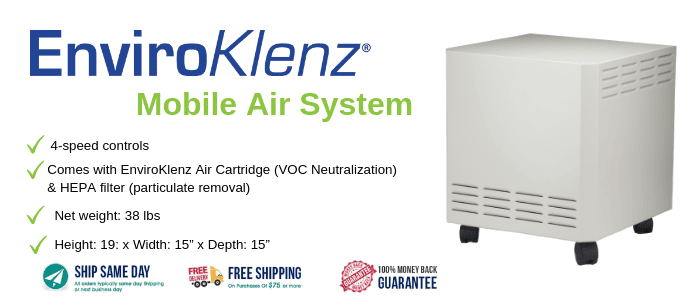
The EnviroKlenz Mobile Air System is your solution to removing VOCs and chemical pollutants from your indoor environment. With the use of a hospital-grade HEPA filter and an effective earth mineral technology air cartridge, this two-stage filtration is perfect to place in your indoor space to mitigate potential hazards to your health. Whether you have chemical sensitivities, allergies, or are just looking to improve your indoor air quality, the EnviroKlenz Mobile Air System is your answer!
- Simple and Easy to Set-Up, with Minimal Maintenance
- Replace Air Cartridge every 4 to 6 Months
- HEPA Filter Replaced Every Two Years
- Quiet Operation, 4-Speed Motor
- No Chemical Odors Released!
We are confident that our EnviroKlenz Technology will drastically reduce the odors in your home, if it doesn’t live up to your expectations, we will issue a full refund within 30 days of your purchase!
Click below to buy NOW!








